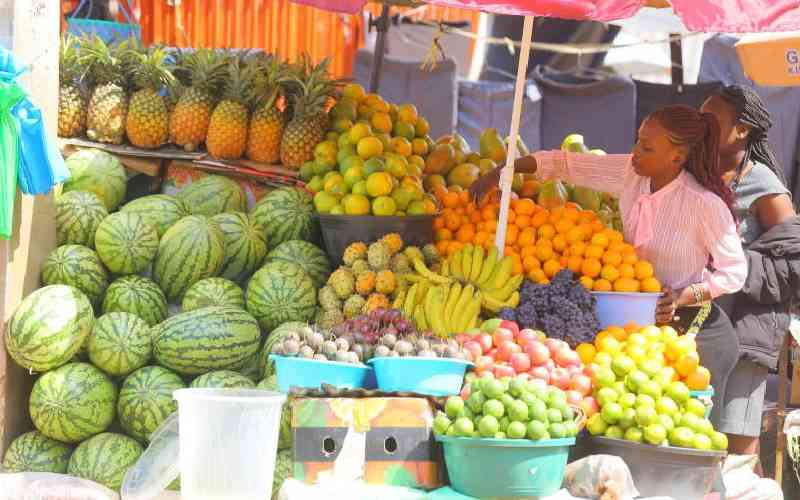By Boniface Gikandi
Lush green vegetation and undergrowth sprout along the banks of a small stream called Mukungai in Murang’a North District.
 |
A stream that almost dried up is back to life after the trees were felled and inset, logs from uprooted trees piled for sale. [PHOTOS: BONIFACE GIKANDI/STANDARD]
|
The stream in Environment Minister John Michuki’s Kangema constituency had almost dried up last year owing to devastating effects of eucalyptus trees planted along its 30km length by tea farmers.
But today, since an order given by the National Environment Management Authority last September to uproot eucalyptus from riverbanks, the dying stream has gained in water volume.
The stream is a beneficiary of a pilot project by the Environment Ministry to test the benefits of doing away with eucalyptus trees, blamed for turning many wetlands into dry zones.
If it succeeds in Murang’a North, then Nema could enforce it countrywide.
Michuki invited Nema to enforce the order in Muranga after he held a water management meeting with local leaders last year. Farmers were ordered to remove all eucalyptus trees ten meters clear of any stream, river or wetland.
Michuki said the eucalyptus trees, locally as munyua mae (water drinker), had rendered formerly succulent lowlands into unproductive dry land.
Many farmers, disillusioned with tea farming, whose earnings had been dropping, resorted to planting eucalyptus, which fetch good returns when sold as timber and wood to tea factories.
Eucalyptus forests, which are said to be the most wasteful water users of all large greenlife in the world, thrived in many valleys of Murang’as tea growing regions.
Farmers were resistant to pull out premature trees when chiefs communicated the Nema order. Many farmers, who had abandoned tea for the tree, stood to lose anticipated timber sale profits but they were persuaded otherwise in barazas.
A Provincial Administration team that went out educating locals against the eucalyptus says they faced resistance.
Locals argued that no research had been done to associate decrease of water levels with proliferation of the trees.
But looking back, the results, even before one year is over, are evident. Streams are filling with water again, wetlands and marshes which had dried up have resurfaced even with the recent little rains.
Stay informed. Subscribe to our newsletter
Pilot scheme
The Murang’a North District uprooting project has been listed as a pilot scheme before the order is enforced in other parts of the country later this year.
Nema is now studying the resurgence of Mukungai stream that cuts across Marimira village from the slopes of the Aberdares. Also being studied is Gachororoma stream that had dried but is coming back to life.
Kangema DO Michael Kibet says the rise in water levels is quickly evident after the trees were felled. Tea processing factories, which had been relying on eucalyptus wood for drying, now support the project and are using bamboo trees instead. Bamboo, according to experts, is a fast growing woody plant.
Murang’a North Nema co-ordinator Mwaniki Njiru says there are three species of bamboo which can replace the eucalyptus.
They are the Arundinaria, Phyllostachya and Sasa, which mature in five years. A giant bamboo tree can grow in five years to more than 40 metres, with a diameter of six inches, said Njiru.
"We are trying to come up with alternatives following concerns over declining water levels caused by eucalyptus," says Kenya Tea Development Agency Regional Manager Alfred Njagi.
Tea factories used to provide free eucalyptus seedlings to farmers to keep their firewood demand fully supplied.
Before the ban by the Government in Murang’a, farmers trooped to the tea factory to get eucalyptus seedlings.
Mr Nicholas Onyango, Ministry of Environment’s public relations officer says bamboo was friendly to water than eucalyptus. Murang’a North DC George Natembeya says since the order to fell eucalyptus was issued for a good cause, it must be complied with.
 The Standard Group Plc is a
multi-media organization with investments in media platforms spanning newspaper
print operations, television, radio broadcasting, digital and online services. The
Standard Group is recognized as a leading multi-media house in Kenya with a key
influence in matters of national and international interest.
The Standard Group Plc is a
multi-media organization with investments in media platforms spanning newspaper
print operations, television, radio broadcasting, digital and online services. The
Standard Group is recognized as a leading multi-media house in Kenya with a key
influence in matters of national and international interest.
 The Standard Group Plc is a
multi-media organization with investments in media platforms spanning newspaper
print operations, television, radio broadcasting, digital and online services. The
Standard Group is recognized as a leading multi-media house in Kenya with a key
influence in matters of national and international interest.
The Standard Group Plc is a
multi-media organization with investments in media platforms spanning newspaper
print operations, television, radio broadcasting, digital and online services. The
Standard Group is recognized as a leading multi-media house in Kenya with a key
influence in matters of national and international interest.








